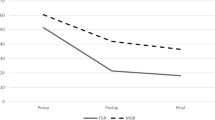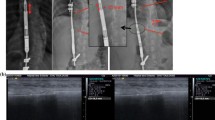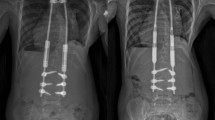Abstract
Introduction
Traditional growing rod (TGR) surgery is a treatment technique commonly used for progressive early-onset scoliosis. Studies have shown that repeated TGR lengthenings can significantly increase the risk of complications. Magnetically controlled growing rods (MCGR) are currently available outside of the United States and early results have been promising. The purpose of this study was to compare the effectiveness of MCGR versus TGR for the treatment of early-onset scoliosis.
Methods
Magnetically controlled growing rod patients were selected based on the following criteria: aged less than 10 years, major curve greater than 30°, thoracic height less than 22 cm, no previous spine surgery, and minimum 2-year follow-up. A total of 17 MCGR patients met the inclusion criteria, 12 of whom had complete data available for analysis. Each MCGR patient was matched with a TGR patient by etiology, gender, single versus dual rods, preoperative age, and preoperative major curve.
Results
Magnetically controlled growing rod patients had a mean age of 6.8 years and mean follow-up of 2.5 years. Mean follow-up was greater for TGR patients by 1.6 years. Major curve correction was similar between MCGR and TGR patients throughout treatment. The MCGR patients experienced an average of 8.1 mm/year increase in T1 –S1 during the lengthening period, compared with 9.7 mm/year for TGR patients (p = .73). There was a mean increase in Tl–T12 of 1.5 mm/year for MCGR patients and 2.3 mm/year for TGR patients (p = .83). The TGR patients had 73 open surgeries, 56 of which were lengthenings. The MCGR patients had 16 open surgeries and 137 noninvasive lengthenings. Three TGR patients underwent 5 unplanned revision surgeries whereas 3 MCGR patients underwent 4 unplanned revisions.
Conclusions
Major curve correction was similar between MCGR and TGR patients throughout treatment. Annual T1–S1 andT1–12 growth was also similar between groups. The MCGR patients had 57 fewer surgical procedures than TGR patients. Incidence of unplanned surgical revisions as a result of complications was similar between groups.
Similar content being viewed by others
References
Waldron SR, Poe-Kochert C, Son-Hing JP, Thompson GH. Early onset scoliosis: the value of serial risser casts. J Pediatr Orthop 2013;33:775–80.
Fletcher ND, Schiller JR, Garg S, et al. Serial casting as a delay tactic in the treatment of moderate-to-severe early-onset scoliosis. J Pediatr Orthop 2012;32:664–71.
Baulesh DM, Huh J, Judkins T, et al. The role of serial casting in early-onset scoliosis (EOS). J Pediatr Orthop 2012;32:658–63.
Karol LA, Johnston C, Mladenov K, et al. Pulmonary function following early thoracic fusion in non-neuromuscular scoliosis. J Bone Joint Surg Am 2008;90:1272–81.
Karol LA. Early definitive spinal fusion in young children: what we have learned. Clin Orthop Relat Res 2011;469:1323–9.
Akbarnia BA, Marks DS, Boachie-Adjei O, et al. Dual growing rod technique for the treatment of progressive early-onset scoliosis: a multicenter study. Spine (Phila Pa 1976) 2005;30 (17 suppl):S46-57.
Bess S, Akbarnia BA, Thompson GH, et al. Complications of growing-rod treatment for early-onset scoliosis: analysis of one hundred and forty patients. J Bone Joint Surg Am 2010;92:2533–43.
Watanabe K, Uno K, Suzuki T, et al. Risk factors for complications associated with growing-rod surgery for early-onset scoliosis. Spine (Phila Pa 1976) 2013;38:E464–8.
Akbarnia BA, Cheung K, Noordeen H, et al. Next generation of growth-sparing techniques: preliminary clinical results of a magnetically controlled growing rod in 14 patients with early-onset scoliosis. Spine (Phila Pa 1976) 2013;38:665–70.
Cheung KM, Cheung JP, Samartzis D, et al. Magnetically controlled growing rods for severe spinal curvature in young children: a prospective case series. Lancet 2012;379:1967–74.
Akbarnia BA, Mundis GM, Salari P, et al. Innovation in growing rod technique: a study of safety and efficacy of a magnetically controlled growing rod in a porcine model. Spine (Phila Pa 1976) 2012;37:1109–14.
Williams BA, Matsumoto H, McCalla DJ, et al. Development and initial validation of the classification of early-onset scoliosis (C-EOS). J Bone Joint Surg Am 2014;96:1359–67.
Dannawi Z, Altaf F, Harshavardhana NS, et al. Early results of a remotely-operated magnetic growth rod in early-onset scoliosis. Bone Joint J 2013;95:75–80.
Hickey BA, Towriss C, Baxter G, et al. Early experience of MAGEC magnetic growing rods in the treatment of early onset scoliosis. Eur Spine J 2014;23 (suppl 1):S61–5.
Author information
Authors and Affiliations
Consortia
Corresponding author
Additional information
Author disclosures: ABA (none); PJB (none); CKMC (none); DG (none); EH (none); EJB (none); JCE (none); MGM (none); NH (none); SDL (grants from POSNA and Scoliosis Research Society; personal fees from Biomet, Medtronic; non-financial support from Growing Spine Study Group, Scoliosis Research Society, Growing Spine Foundation Medtronic Strategic Advisory Board; personal fees from expert testimony; personal fees from Biomet, Medtronic, Stryker, Wolters Kluwer Health—Lippincott Williams & Wilkins; other from Medtronic, Stryker, Biomet, Medtronic, outside the submitted work; patent issued by Medtronic); SPD (none); TGH (none); YB (none); YM (none).
This study was financially supported by the Growing Spine Foundation and Ellipse Technologies.
Rights and permissions
About this article
Cite this article
Akbarnia, B.A., Pawelek, J.B., Cheung, K.M.C. et al. Traditional Growing Rods Versus Magnetically Controlled Growing Rods for the Surgical Treatment of Early-Onset Scoliosis: A Case-Matched 2-Year Study. Spine Deform 2, 493–497 (2014). https://doi.org/10.1016/j.jspd.2014.09.050
Received:
Revised:
Accepted:
Published:
Issue Date:
DOI: https://doi.org/10.1016/j.jspd.2014.09.050




